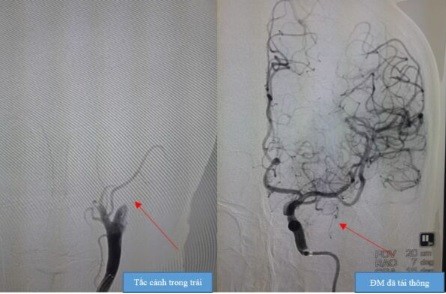“Over 50% of vertebral strokes do not have focal neurological deficits, patients only present with dizziness. Every year, about 2.6 million dizziness patients are admitted to the emergency room, 5% (100,000-150,000) have stroke, most of the brain stem or lower cerebellum area, 40% of misdiagnosis, death or disability is very high”, BSCKII. Bui Thi Thu Ha – Director of Stroke Center, Phu Tho Provincial General Hospital said.
Subjective dizziness, unpredictable consequences
Stroke Center, Phu Tho General Hospital has just received an 85-year-old male patient, admitted to the hospital with symptoms of dizziness on the second day. The patient at home received an infusion and took medicine but did not improve. On the second day, the family called to ask questions and the patient did not answer, so he went to the hospital.
Results of cranial MRI scan: There was an image of damage to the cerebellum and brain stem due to basilar blockage but it was past the intervention time. The patient and his family missed the golden time to save the patient’s life. Currently, the patient is in a coma, G: 3 points, on a ventilator, with a grave prognosis.
| Doctor takes care of stroke patients at Phu Tho General Hospital. |
Similarly, a 66-year-old male patient (Phu Tho) was also hospitalized due to prolonged dizziness and facial paralysis. The patient had symptoms of dizziness and self-treatment at home but it did not help. The next day, the dizziness increased with a distorted mouth, so the family took him to the hospital. On the brain MRI scan, there was an image of cerebral infarction in the cerebellum and right pons. However, because the patient was hospitalized on the second day of symptoms, past the golden hour, treatment with thrombolytic drugs was not prescribed, missing the patient’s opportunity for a quick recovery.
BSCKII. Bui Thi Thu Ha said that many stroke patients pay the price with their lives and health. Patients are all subjective with the symptoms of dizziness and vestibular confusion… without knowing it could be a dangerous disease – stroke.
 |
| Results of brain MRI of stroke patients. |
Dizziness is a common symptom in all ages caused by many different causes: Changes in blood pressure, cerebral vascular spasm, cerebellar infarction, cerebral and vestibular ischemia, and damage to nerve VIII. .. Dizziness is divided into 2 types:
Central vertigo is caused by problems from the brain. The cerebellum is the part of the brain most affected (common in stroke).
Peripheral vertigo often occurs due to damage to the inner ear or vestibular nerve. Peripheral vertigo is benign but causes discomfort for the patient.
Acute vestibular syndrome common causes include vestibular neuritis (labyrinthitis) and central lesions (vertebrobasilar stroke (83%), multiple sclerosis (11%), other causes (6% ).Over 50% of vertebrobasilar strokes do not have focal neurological deficits, patients only present with vertigo.
If not diagnosed early, lower cerebellar stroke can cause cerebellar edema, brain stem compression, and death. Failure to diagnose the cause and early preventative treatment of acute vestibular syndrome due to anemia also leads to the risk of recurrent stroke.
“In many cases, people with stroke only have “transient” symptoms of dizziness, about an hour later, then gradually subside, but that does not mean they are fine. Because the blockage of a small blood vessel will cause a small portion of brain tissue to be temporarily ischemic and soon be restored by a self-rupturing blood clot (due to its small size), or this brain tissue may receive blood flow from a branch. adjacent blood vessels. However, for every 10 patients who have a “transient” ischemic attack, 1 will have a real stroke in the next week,” Dr. Ha emphasized.
Therefore, when there are symptoms of dizziness, patients should be examined by a neurologist to find the cause and treat it on target.
Increased stroke because of cold weather
Dr. Nguyen Van Tuyen, Center Director brain stroke Central Hospital 108 warns that the North is entering weather with plummeting temperatures, which can cause weather-related diseases to flare up, especially strokes – cerebrovascular accidents. Unusually cold weather at night and morning is also the cause of increased hospitalizations due to stroke complications.
Statistics from the Stroke Center of Central National Hospital 108 show that the average number of patients hospitalized for stroke in the cold season increases from 15% to 30%. In particular, when the weather is deeply cold or severely cold, the number of disease cases increases abnormally. Not only new cases, people with a history of stroke or accident are also at higher risk of recurrence.
According to statistics, the total number of stroke cases accounts for 85%. cause of stroke is due to cerebral ischemia, while the remaining 15% of strokes are due to cerebral hemorrhage.
Usually, the symptoms before a stroke are painless and even happen quickly, making the patient subjective and unaware that a stroke is about to occur. Symptoms are only apparent when the patient has ruptured a blood vessel in the brain. Therefore, it is important to detect it early.
According to Associate Professor. Dr. Mai Duy Ton, Director of Bach Mai Stroke Center, during the winter months, the number of patients hospitalized increases significantly, and the number of severe cases also increases.
The study examined nearly 172,000 hospitalizations for ischemic stroke in the United States and found that strokes increased significantly in colder weather and especially when there were large fluctuations in temperature.
A German study found that, when the temperature drops 2.9oC in 24 hours, stroke increases by 11% and in particular, this rate will be higher for people with existing risk of stroke such as: Hypertension pressure, diabetes, cardiovascular disease,…
The risk of stroke increases by 80%, especially when the temperature drops below 15 degrees Celsius and the temperature drops suddenly. The reason is that cold temperatures can cause blood vessels to constrict, causing increased blood pressure. And it can also thicken the blood, which can lead to blood clots.
Furthermore, in cold weather, many people are lazy to exercise, a lot of stress combined with unhealthy habits such as eating and drinking too much… also increases the risk of stroke.
How to prevent stroke when it’s cold
1. Avoid sudden exposure to cold weather, especially when the weather is below 15oC. Wear appropriate warm clothes when going out: wear a wool hat, gloves, shoes, warm clothes…
2. Regularly monitor blood pressure when the weather changes and immediately notify your doctor when blood pressure increases abnormally.
3. See your doctor regularly to control underlying diseases such as hypertension, diabetes, cardiovascular disease, etc.
4. Maintain regular physical activity. Lose weight and maintain a healthy weight.
5. Practice a healthy eating lifestyle: do not eat salty foods, limit foods high in cholesterol. Don’t drink alcohol and eat too much.
6. Avoid tension and stress.
7. Do not smoke cigarettes or tobacco.
Stroke is the third leading cause of death in the world after cardiovascular disease and cancer and is one of the leading causes of disability. Those who escape death often leave behind severe physical and mental sequelae as well as being a burden to their families and society.
The annual cost of stroke treatment in the US is $36.5 billion, including medication, medical care, and days off work. In Vietnam, there are no exact figures on the cost of stroke treatment. The risk of stroke increases with age, doubling every 10 years after age 55; approximately 28% of strokes occur under age 65. It is predicted that by 2025 in the US, about 18.7% of the population will have a stroke.

